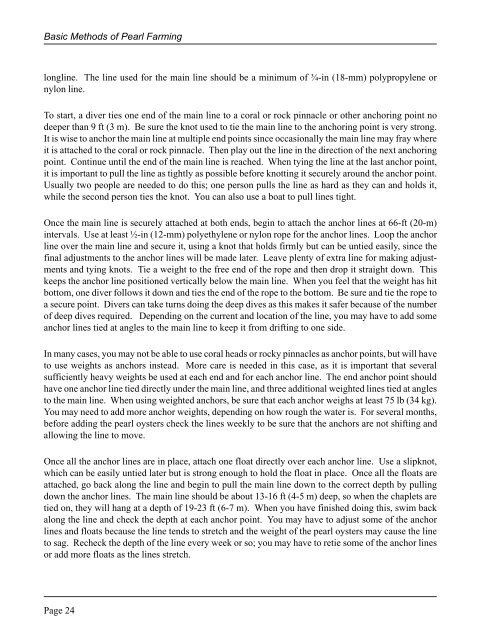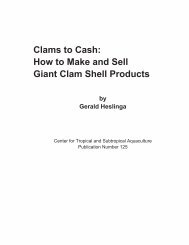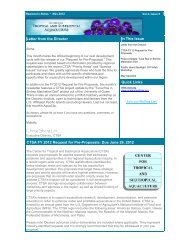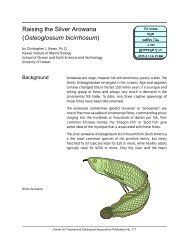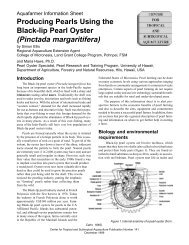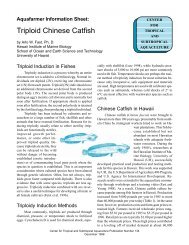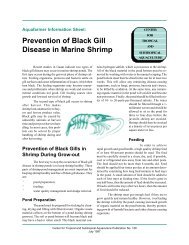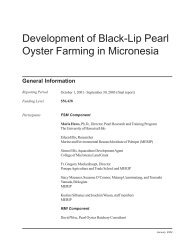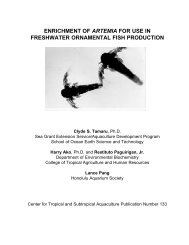The Basic Methods of Pearl Farming: A Layman's Manual - CTSA
The Basic Methods of Pearl Farming: A Layman's Manual - CTSA
The Basic Methods of Pearl Farming: A Layman's Manual - CTSA
You also want an ePaper? Increase the reach of your titles
YUMPU automatically turns print PDFs into web optimized ePapers that Google loves.
<strong>Basic</strong> <strong>Methods</strong> <strong>of</strong> <strong>Pearl</strong> <strong>Farming</strong>longline. <strong>The</strong> line used for the main line should be a minimum <strong>of</strong> ¾-in (18-mm) polypropylene ornylon line.To start, a diver ties one end <strong>of</strong> the main line to a coral or rock pinnacle or other anchoring point nodeeper than 9 ft (3 m). Be sure the knot used to tie the main line to the anchoring point is very strong.It is wise to anchor the main line at multiple end points since occasionally the main line may fray whereit is attached to the coral or rock pinnacle. <strong>The</strong>n play out the line in the direction <strong>of</strong> the next anchoringpoint. Continue until the end <strong>of</strong> the main line is reached. When tying the line at the last anchor point,it is important to pull the line as tightly as possible before knotting it securely around the anchor point.Usually two people are needed to do this; one person pulls the line as hard as they can and holds it,while the second person ties the knot. You can also use a boat to pull lines tight.Once the main line is securely attached at both ends, begin to attach the anchor lines at 66-ft (20-m)intervals. Use at least ½-in (12-mm) polyethylene or nylon rope for the anchor lines. Loop the anchorline over the main line and secure it, using a knot that holds firmly but can be untied easily, since thefinal adjustments to the anchor lines will be made later. Leave plenty <strong>of</strong> extra line for making adjustmentsand tying knots. Tie a weight to the free end <strong>of</strong> the rope and then drop it straight down. Thiskeeps the anchor line positioned vertically below the main line. When you feel that the weight has hitbottom, one diver follows it down and ties the end <strong>of</strong> the rope to the bottom. Be sure and tie the rope toa secure point. Divers can take turns doing the deep dives as this makes it safer because <strong>of</strong> the number<strong>of</strong> deep dives required. Depending on the current and location <strong>of</strong> the line, you may have to add someanchor lines tied at angles to the main line to keep it from drifting to one side.In many cases, you may not be able to use coral heads or rocky pinnacles as anchor points, but will haveto use weights as anchors instead. More care is needed in this case, as it is important that severalsufficiently heavy weights be used at each end and for each anchor line. <strong>The</strong> end anchor point shouldhave one anchor line tied directly under the main line, and three additional weighted lines tied at anglesto the main line. When using weighted anchors, be sure that each anchor weighs at least 75 lb (34 kg).You may need to add more anchor weights, depending on how rough the water is. For several months,before adding the pearl oysters check the lines weekly to be sure that the anchors are not shifting andallowing the line to move.Once all the anchor lines are in place, attach one float directly over each anchor line. Use a slipknot,which can be easily untied later but is strong enough to hold the float in place. Once all the floats areattached, go back along the line and begin to pull the main line down to the correct depth by pullingdown the anchor lines. <strong>The</strong> main line should be about 13-16 ft (4-5 m) deep, so when the chaplets aretied on, they will hang at a depth <strong>of</strong> 19-23 ft (6-7 m). When you have finished doing this, swim backalong the line and check the depth at each anchor point. You may have to adjust some <strong>of</strong> the anchorlines and floats because the line tends to stretch and the weight <strong>of</strong> the pearl oysters may cause the lineto sag. Recheck the depth <strong>of</strong> the line every week or so; you may have to retie some <strong>of</strong> the anchor linesor add more floats as the lines stretch.Page 24


